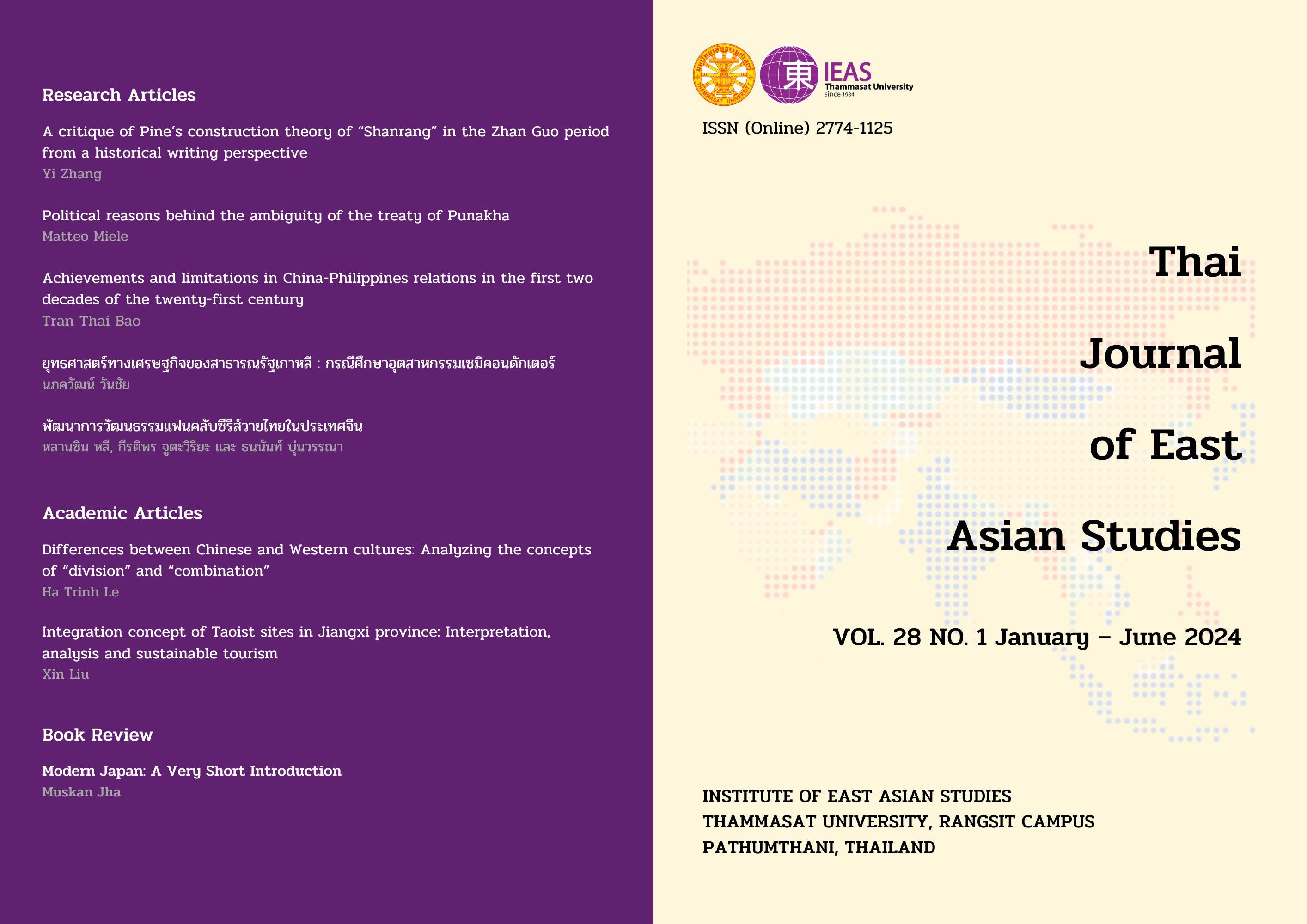Development of Thai Y series fan culture in China
Keywords:
Fan culture, Thai Y series in China, Chinese fansAbstract
This research article aims to study the development of Thai Y series fan culture in China. Employing a documentary research approach within the framework of fan culture theories, this study draws upon content analysis sourced from the discourse of Chinese fans on the Weibo platform. The findings reveal three distinct phases in the development of Thai Y series fan culture in China. Phase 1 (2014-2018): Chinese fans relied on subtitle groups to access and engage with Thai Y series. However, faced with copyright constraints, Chinese fans adapted their viewing practices by accessing Y-Thai series content via cloud drives in conjunction with subtitle groups. Phase 2 (2019-2021): The blossoming growth of Thai Y series and widespread popularity in China. As Thai Y series gained mainstream recognition in China, fans became increasingly interested in the symbolic and identity-related benefits associated with consuming products related to their favorite artists, rather than the practical use of these products. Phase 3 (2022-present): Diversity in the fan culture of Thai Y series. In recent years, Chinese fans have gained greater opportunities to interact with Thai Y series artists. This has led to an increase in transnational business value, benefiting both the Thai Y series artists and their devoted fans. Additionally, fans are increasingly being incorporated into the production and marketing of Thai Y series, as well as creating a fan culture in business that connects with other countries in the Mekong Basin.
Downloads
References
การเงินธนาคาร. (2566, 11 กรกฎาคม). ซีรีส์วายไทย ขึ้นแท่นเบอร์ 1 โลก ผู้ผลิตจ่อเข็นซอฟต์พาวเวอร์ไทยเทียบชั้นเกาหลี. https://moneyandbanking.co.th/2023/48928
ชุมชนชาวฮว้าในแพลตฟอร์มเวยป๋อ. (2566). ผลสำรวจซีรีส์วายคู่จิ้นไทยได้รับนิยมในชุมชนชาวฮว้าในเวยป๋อ (ค.ศ. 2014 - ค.ศ. 2023). Weibo. https://m.weibo.cn/p/tabbar?containerid=100803_-_super&wm=3333_2001&from=10DA093010&sourcetype=qq&uid=6469317392&s_trans=6469317392_&s_channel=6
ซี้แฟนยี่จื้อจี้ว์. (2566). กลุ่มคำบรรรยายที่แปลซีรีส์วายไทยและซีรีส์วายอื่น ๆ เป็นภาษาจีน โดยเฉพาะซีรีส์วายในประเทศอนุภูมิภาคลุ่มน้ำโขง. Weibo. https://weibo.com/u/6319447640
เทียนฝู่ไท่จี้ว์. (2566). กลุ่มคำบรรรยายที่แปลซีรีส์วายไทยและซีรีส์วายอื่น ๆ เป็นภาษาจีน. Weibo. https://weibo.com/u/2117871375
บัญชีทางการในเวยป๋อของแฟนคลับ หลิงหยู่หยันเนิงลิ่จื้อ (零语言能力者). (2564). โพสต์การแปลภาษาไทยที่เกี่ยวกับศิลปินบิวกิ้นกล่าวถึงเทศกาลดนตรีจีนในเมืองชิงเต่า. Weibo. https://weibo.com/6316920547/4924581518770228
บัญชีทางการในเวยป๋อของยี่ห้อไทย Taro. (2566). ข่าวสารเชิญศิลปินซีรีส์วายไทยและถ่ายทอดสดในการขายของ. Weibo. https://weibo.com/u/7310983522
บัญชีทางการในเวยป๋อของบริษัท Mistine. (2566). ข่าวสารเชิญศิลปินซีรีส์วายไทยและถ่ายทอดสดในการขายของ. Weibo. https://weibo.com/u/3288352831
บริษัทจีเอ็มเอ็มทีวี (GMMTV). (2566). ประกาศจัดคอนเสิร์ตและแฟนมีตติ้ง ศิลปินซีรีส์วายไทยของบริษัทจีเอ็มทีวี ในต่างประเทศ [Status update]. Facebook. https://www.facebook.com/gmmtvofficial?mibextid=LQQJ4d
ภัณฑิรา สมประเสริฐสุข. (2563). การศึกษาทัศนคติและพฤติกรรมของกลุ่มแฟนคลับBNK48 ในเขตกรุงเทพมหานคร. [วิทยานิพนธ์ปริญญานิเทศศาสตรมหาบัณฑิต, มหาวิทยาลัยกรุงเทพ]. DSpace at Bangkok University.
วสิทธิ์ สถิตวรพงศ์. (2565, 9 กันยายน). อะไรคือ “วัฒนธรรม Y”? :จาก “แฟนฟิคญี่ปุ่น” ถึง “ซีรีส์ไทย”. FEE:D. https://feedforfuture.co/feed-read/8659
ศูนย์ข้อมูลเวยป๋อ. (2564). รายงานการพัฒนาผู้ใช้ของเวยเป๋อในปี ค.ศ 2020 (微博 2020 用户发展报告). Weibo. https://weibo.com/ttarticle/p/show?id=2309404613871951282183
อรสุธี ชัยทองศรี. (2560). Boys Love Manga and Beyond: History, Culture, and Community in Japan. Journal of Studies in the Field of Humanities, 24(2), 344-359.
Bao, Z.P. (2013). 媒介粉丝文化与女性主义 . Nankai Journal (Philosophy, Literature and Social Science Edition), (06), 120-129.
Gao, Y.B. (2020). 从粉丝到粉圈. [Master’s thesis of Social Sciences, Shanghai Academy]. https://kns.cnki.net/KCMS/detail/detail.aspx?dbname=CMFD202101&filename=1020908089.nh
Jenkins, H. (1992). Textual poachers: Television fans and participatory culture. Routledge.
Jenkins, H. (2012). 融合文化:新媒体和旧媒体的冲突地带. (Yongming, D., Trans.). Commercial Press. (Original work published 2006).
Jirattikorn, A. (2023). Heterosexual Reading vs. Queering Thai Boys’ Love Dramas among Chinese and Filipino Audiences. Gender and Sexuality in Asia and the Pacific, 49. https://doi.org/10.25911/R1B3-1K82
Oxford University. (2023). The Oxford English Dictionary. Oxford University Press. https://www.oed.com/search/dictionary/?scope=Entries&q=fan
Prasannam, N. (2019). The Yaoi phenomenon in Thailand and fan/industry interaction. Plaridel, 16(2), 63-89. https://doi.org/10.52518/2020.16.2-03prsnam
Ran, H., & Zhang, Y. X. (2020). 媒介迷群的权力生产与规训: 基于超话社区耽美迷群的参与 式观察. Southeast spread, (2), 13-15.
Sullivan, J. (2013). Media fandom and audience subcultures. In Media audiences: Effects, users, institutions and power. Sage.
Tian, X. (2008). 价值观的沦丧抑或是社会文化的缺失——当 “耽美”成为一种亚文化的流行指标. Contemporary literature, (10), 112-113.
Wang, E. N., & Ge, L. (2022). Fan conflicts and state power in China: Internalised heteronormativity, censorship sensibilities, and fandom police. Asian studies review, 47(2), 355-373.
Wang, Y., & Tan, J. (2023). Participatory Censorship and Digital Queer Fandom: The Commercialization of Boys’ Love Culture in China. International Journal of Communication, (17), 2554–2572.
Yang, L. (2009). 粉丝, 情感经济与新媒介. Social science Front, (7), 173-177.
Zhang, J. (2021). The Reception of Thai Boys Love Series in China: Consumption, Imagination, and Friction. [Senior Honors Thesis, the University of North Carolina at Chapel Hill]
Downloads
Published
How to Cite
Issue
Section
License
Copyright (c) 2024 Thai Journal of East Asian Studies

This work is licensed under a Creative Commons Attribution-NonCommercial-NoDerivatives 4.0 International License.



